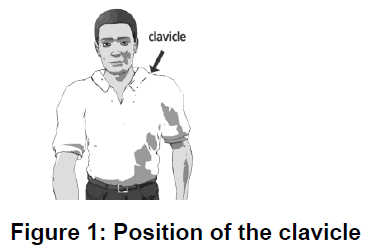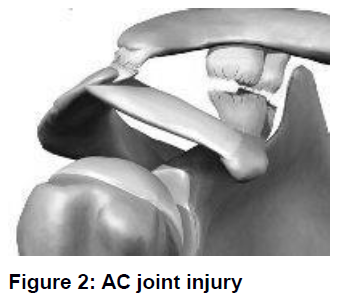Fractured clavicle and acromioclavicular (AC) joint injuries
This page has been given to you because you have injured your shoulder. An X-ray suggests that you have fractured your clavicle (sometimes known as your collar bone) or injured your acromioclavicular (AC) joint. The AC joint is where your clavicle meets your shoulder.
What are these injuries?
Both a fractured clavicle and an AC joint injury usually happen when you fall onto the edge of your shoulder during sport such as rugby or football. It can also happen if you fall with your arm outstretched.
In these instances, forces are transmitted up through the arm and into the shoulder. If the forces are severe enough, they may cause the clavicle to break or the AC joint to become damaged.
What is a fractured clavicle?
A fractured clavicle is a break, or bend, in your collar bone. This is one of the most common fractures seen in sport.
Treatment for a fractured clavicle
This is a painful injury which is usually treated without surgery, even in cases where the bone appears out of place. Treatment is aimed at reducing pain and holding the bones steady to help with healing.
To help keep your shoulder still, we will apply a broad arm sling which we recommend you use for up to 2 weeks.
It is not possible to completely immobilise (stop from moving) this bone. Therefore, while the fracture is healing, large or wide arm movements should be avoided as they will be painful.
If the bones are particularly out of place you may be referred to the Trauma Service who will advise you about further treatment options.
What is an AC joint injury?
An AC joint injury is also known as a ‘shoulder separation’. This is not the same as a shoulder dislocation.
The AC joint is at the top of your shoulder between your clavicle and your scapula (shoulder blade). It allows you to move your arm over your head and across your body.
There are a number of ligaments (which are similar to elastic bands) around the joint to keep it stable. Most injuries happen when these ligaments are overstretched. The amount of damage can vary from a mild sprain to a complete tear.
Any X-rays taken will be reviewed by our radiologists. If there is any concern that there may be a more serious injury, you will be contacted and may be asked to attend a follow up appointment. However, if your symptoms become worse or you have any concerns, please seek advice from the one of the services listed at the end of this page.
AC joint injury treatment
Most patients with an AC joint injury start to feel better within a week of the injury. However, full ligament healing will take at least 8 weeks. During this time, it is important to protect the damaged ligaments from overstretching the healing ligaments. It can be helpful to use a broad arm sling for 1 to 2 weeks as this will reduce the strain on your AC joint.
Managing the pain
Both injuries are painful and regular pain relief, such as paracetamol, is recommended. Please follow the dosage instruction in the pack. Your local pharmacist can advise you if you are taking other medication.
Important information
Rarely, a broken collar bone can cause more serious injuries which need urgent treatment. We advise you to contact NHS 111 or return to your local Emergency Department if you:
- have chest pain.
- have difficulty breathing.
- are coughing up blood.
- have a bone sticking out of your skin.
- have pins and needles in your arm or hand.
Follow up
These injuries usually heal well and no further treatment is needed. A follow-up appointment is not necessary.
Contact sports (such as football, rugby and basketball) should be avoided for at least 6 weeks.
Contact information
If you have any concerns about your injury, please seek advice from either of the following:
Trauma Service
Tel: 0300 422 5269
Monday to Friday, 10:00am to 2:00pm
Email: ghn-tr.glostrauma@nhs.net
NHS 111
Tel: 111

